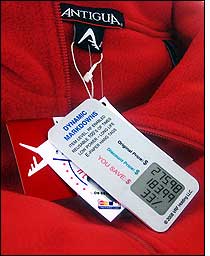Of all the benefits the retail sector stands to reap from RFID technology, the automation of product price markdowns receives far less attention than other applications, such as product tracking. That’s because retailers lack a means of easily communicating sale prices to consumers, via RFID tags, as they browse through items in a store. But a startup company known as VRF-Holding may have developed a way to make it easier for stores to execute markdowns and communicate them to customers.
VRF-Holding announced and demonstrated dynamic item-level markdown tags at last month’s RFID Journal LIVE! 2008 conference in Las Vegas. The company has developed three prototype battery-assisted passive (BAP) or active tags, each containing dynamic electronic paper (e-paper) displays. The tags, VRF claims, can be utilized for automatic markdowns, as well as for inventory and theft control within retail settings.

E-paper is the technology employed in some electronic book readers, such as Amazon‘s Kindle, released in late 2007. Whereas conventional displays incorporate a backlight and require a steady power supply, e-paper is illuminated by external ambient light. Once text or an image is set on the display, it remains there indefinitely, without drawing electricity, until altered through a user’s input.
“The e-paper is also very durable, as there is no glass used in the display, and it is able to withstand up to 1,200 pounds per square inch of pressure, and a 6-foot drop,” says Ed Holcomb, a managing partner of VRF Holding. “The display technology is really cool, but updating the display with RF is where the patents come into play. We have worldwide exclusive rights for bistable displays [such as e-paper] using wireless communications for item-level hangtags.”
The screens of the VRF tags will be set to show a product’s original and current prices, as well as the amount saved, or they could be customized to meet a retailer’s specific requirements. One version, made for VRF by tag maker Intelleflex, contains an EPC Gen 2 UHF chip and a battery used to extend the tag’s read range to as much as 100 feet, and to power its display. The tag complies with the EPCglobal candidate Class 3 specification for a BAP tag.
According to Holcomb, another prototype, produced by wireless-sensor manufacturer Jennic, complies with the IEEE 802.15.4 standard—the same specification on which the ZigBee protocol is based—and has a read range of approximately 900 feet. A third model, he says—currently in development—is based on a low-power Wi-Fi chipset and should offer a communication range of up to 1,000 feet.
The EPC Gen 2 and ZigBee prototypes measure 3.5 inches long by 1.7 inches wide, and are roughly an eighth of an inch thick. The prototype Wi-Fi tag will be a bit thinner, Holcomb says, adding that VRF hopes to downsize all three tags to about 3 by 1.25 inches, and to as thin as one-eighteenth of an inch.
The benefits of the system could be significant. To mark down products, retailers generally utilize price guns to cover higher-price stickers with lower ones, though smaller retailers may simply use a pen to cross out an older amount and write a new one by hand. According to Holcomb, a considerable amount of an employee’s time is spent dealing with pricing issues. The University of Arkansas’s RFID Research Center has been conducting tests of the VRF tags for half a year, though it has not yet published details or results of those tests. Another retailer, which Holcomb says he cannot name at this time, spends $500 million on total labor each year to staff its 890 stores with 30,000 employees. The single largest line item of that expenditure, he notes, is the cost of having workers perform manual product markdowns.
Holcomb says the battery in both the Intelleflex and Jennic tags is good for up to five years, though he hopes, in the future, to be able to extend that tag life through the use of power controllers or energy harvesters. He expects the Wi-Fi version of the tag to contain a battery with a two-year life.
By marketing markdown tags in several formats, VRF is striving to appeal to a wide range of end users. Some users will favor the use of an EPC-compliant tag, while others will prefer long battery life coupled with extended read range, offered in the IEEE 802.15.4 model. Still others might want a Wi-Fi tag to leverage an installed Wi-Fi infrastructure, though the Wi-Fi tag’s power consumption and lower battery life could turn some retailers off. Holcomb declines to reveal pricing for the tags, but says interrogators for the 802.15.4 tags cost less than $100 apiece, whereas the readers required for the EPC tags are considerably more expensive.
VRF software, Holcomb says, can be linked to a retailer’s point-of-sale software to control the data displayed on the tags, and the displayed pricing can be optimized by season, weather, region, special events, day of the week or time of day. VRF is initially focusing on the retail footwear and apparel market, Holcomb says, and is presently seeking customers such as department stores, specialty stores, boutiques and off-price stores. “VRF has recently opened discussions with several retailers,” he states, “to evaluate pilot sites for its dynamic markdown tags in the U.S., Europe and South America.”
In addition, VRF is working to establish a strategic partner/integrator relationship with a large RFID company—Holcomb names Motorola, NCR, Checkpoint Systems, Zebra Technologies and IBM as targets—to bring its tags to market. The company is currently looking for end-user companies interested in testing the prototype tags.

